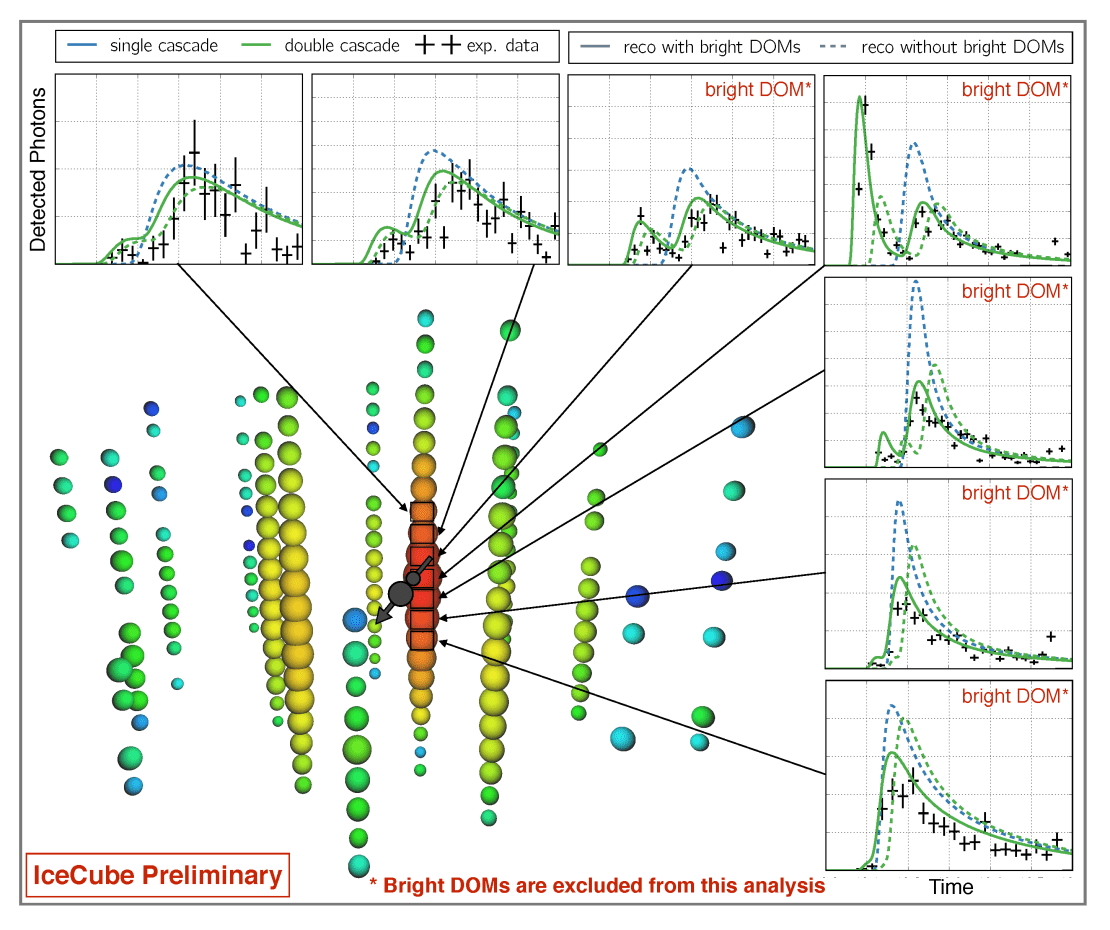The IceCube Collaboration has reported two candidate events for the final unobserved Standard Model cosmic messenger: astrophysical tau neutrinos. And one of these neutrino events, as with previous prominent particles detected by the IceCube Neutrino Observatory, has been given its own nickname.
Double Double, an event with a high probability of being produced by a tau neutrino interaction with the South Pole ice, occurred in 2015. It is an example of a specific flavor of neutrino, a fundamental particle whose other flavors—electron and muon—have been observed in abundance. This new detection is the first time a telescope has seen this specific flavor of high-energy cosmic neutrino with such certainty.
The IceCube Collaboration published these results on November 15, 2022, in The European Physical Journal C.
What makes tau neutrinos so interesting is that they are much more difficult to produce than electron and muon neutrinos, both in atmospheric cosmic ray showers and at cosmic accelerators. However, as neutrinos travel from their mighty, distant sources to Earth, they oscillate—a quantum phenomenon that mixes the flavor composition of neutrinos and predicts that roughly 1/3 of them will arrive at IceCube with the tau flavor.
“There should be astrophysical tau neutrinos in our data, but we hadn’t been able to identify them yet,” explains Juliana Stachurska, the main analyzer and a PhD student at Deutsches Elektronen-Synchrotron (DESY) in Zeuthen, Germany, at that time.
Because atmospheric tau neutrinos are expected to be exceedingly rare, a tau neutrino at the energies explored in this study, ranging from 60 TeV to 10 PeV, becomes a smoking-gun signature of an astrophysical neutrino.
After a decade of IceCube observations and many high-energy neutrinos on the books, one may wonder why a tau neutrino had not been identified long ago. The reason is the intrinsic nature of tau leptons, elementary particles similar to electrons but with a mass over 3,000 times larger, which leads to a prompt decay very close to the initial neutrino interaction. The expected decay length rises with energy of the initial neutrino and in rare cases can reach greater than 10 meters, sufficient to separate the interaction and decay.

When an astrophysical tau neutrino enters the ice sheet in Antarctica and interacts with one of its molecules, it produces a shower of subatomic particles that includes a tau. This tau lepton will then rapidly decay into a second shower of particles that will finally be absorbed by matter. If this happens inside IceCube, a portion of the 5,160 optical sensors that make up the detector will record the two showers. However, in most cases, the event will be seen as only one cascade of high-energy particles due to the proximity, both in time and distance, of the neutrino interaction and the secondary tau decay.
But now a double cascade has been observed in IceCube for the first time. This Double Double event, as it has been dubbed, has an energy of about 100 TeV and is reconstructed as exactly two energy depositions (indicative of a tau neutrino) some 17 meters apart. The few sensors closest to the interaction point captured two light peaks separated in time. This light is produced by the rapid movement of high-energy particles that travel faster than light in the ice and create a cone of blue light called Cherenkov radiation—much like a sonic boom, but with light instead of sound.
“We are 99.5% confident that we have astrophysical tau neutrinos in our data. This is not a discovery—yet—but the next few years will yield more sensitive analyses, and the observance of tau neutrinos will be more frequent,” adds Stachurska.
These events will be even more common when the proposed next-generation extension of IceCube, the so-called IceCube-Gen2, becomes a reality. Then, tau neutrinos will bring us new information about the environments around cosmic accelerators, or maybe they will reveal fundamental new physics that affects neutrino oscillations during the long journey to Earth.
Double Double was found in a set of 7.5 years of IceCube data that included 60 high-energy starting events, which are events with a neutrino interaction taking place inside the telescope. Improved analysis techniques have allowed identifying two double-cascade events from this set. The most energetic one, known as Big Bird, was originally detected in 2012 and, at that time, was the highest energy neutrino ever seen. This analysis has shown that this event was three times more likely to have been produced by a tau neutrino than by an electron neutrino. For Double Double, this probability rises to 80 times.
“We have likely seen the last Standard Model cosmic messenger to be detected. And what’s amazing is that it looked exactly like what we expected to see from a tau neutrino,” comments Stachurska.
+ info “Detection of astrophysical tau neutrino candidates in IceCube,” IceCube Collaboration: R. Abbasi et al.,The European Physical Journal C 82 (2022) 11, 1031 (2022), DOI:10.1140/epjc/s10052-022-10795-y, arXiv.org/abs/2011.03561